Improving the Performance of ZnS Photocatalyst in Degrading Organic Pollutants by Constructing Composites with Ag2O
Abstract
1. Introduction
2. Materials and Methods
2.1. Chemicals
2.2. Synthesis of ZnS Broccoli-Like Microspheres
2.3. Synthesis of ZnS/Ag2O Composite
2.4. Characterizations of Samples
2.5. Photocatalytic Activity Tests
3. Results and Discussion
4. Conclusions
Author Contributions
Funding
Data Availability Statement
Conflicts of Interest
References
- Malik, R.; Tomer, V.K.; Joshi, N.; Dankwort, T.; Lin, L.; Kienle, L. Au–TiO2-loaded cubic g-C3N4 nanohybrids for photocatalytic and volatile organic amine sensing applications. ACS Appl. Mater. Interfaces 2018, 10, 34087–34097. [Google Scholar] [CrossRef]
- Praus, P.; Svoboda, L.; Tokarsk´y, J.; Hospodková, A.; Klemm, V. Core/shell CdS/ZnS nanoparticles: Molecular modelling and characterization by photocatalytic decomposition of Methylene Blue. Appl. Surf. Sci. 2014, 292, 813–822. [Google Scholar] [CrossRef]
- Prasannalakshmi, P.; Shanmugam, N. Fabrication of TiO2/ZnS nanocomposites for solar energy mediated photocatalytic application. Spectrochim. Acta A 2017, 175, 1–10. [Google Scholar] [CrossRef]
- Wang, H.; Liang, L.; Cheng, X.; Luo, Y.; Sun, S. Facile fabrication of porous ZnS and ZnO films by coaxial electrospinning for highly efficient photodegradation of organic dyes. Photochem. Photobiol. 2018, 94, 17–26. [Google Scholar] [CrossRef]
- Reddy, D.A.; Choi, J.; Lee, S.; Kim, T.K. Controlled synthesis of heterostructured Ag@AgI/ZnS microspheres with enhanced photocatalytic activity and selective separation of methylene blue from mixture dyes. J. Taiwan Inst. Chem. Eng. 2016, 66, 200–209. [Google Scholar] [CrossRef]
- Hu, L.; Chen, F.; Hu, P.; Zou, L.; Hu, X. Hydrothermal synthesis of SnO2/ZnS nanocomposite as a photocatalyst for degradation of Rhodamine B under simulated and natural sunlight. J. Mol. Catal. A-Chem. 2016, 411, 203–213. [Google Scholar] [CrossRef]
- Yang, L.; Guan, X.; Wang, G.S.; Guan, X.H.; Jia, B. Synthesis of ZnS/CuS nanospheres loaded on reduced graphene oxide as high-performance photocatalysts under simulated sunlight irradiation. New J. Chem. 2017, 41, 5732–5744. [Google Scholar] [CrossRef]
- Harish, S.; Prachi; Archana, J.; Navaneethan, M.; Shimomura, M.; Ikeda, H.; Hayakawa, Y. Synergistic interaction of 2D layered MoS2/ZnS nanocomposite for highly efficient photocatalytic activity under visible light irradiation. Appl. Surf. Sci. 2019, 488, 36–45. [Google Scholar] [CrossRef]
- Liu, Q.; Cao, J.; Ji, Y.; Li, X.; Li, W.; Zhu, Y.; Liu, X.; Li, J.; Yang, J.; Yang, Y. Construction of a direct Z-scheme ZnS quantum dot (QD)-Fe2O3 QD heterojunction/reduced graphene oxide nanocomposite with enhanced photocatalytic activity. Appl. Surf. Sci. 2020, 506, 144922. [Google Scholar] [CrossRef]
- Janani, R.; Melvin, A.A.; Singh, S. Facile one pot in situ synthesis of ZnS-ZnIn2S4 composite for improved photocatalytic applications. Mater. Sci. Semicond. Process 2021, 122, 105480. [Google Scholar] [CrossRef]
- Su, Y.; Zhao, X.; Bi, Y.; Han, X. ZnO/Ag-Ag2O microstructures for high-performance photocatalytic degradation of organic pollutants. Clean Techn. Environ. Policy 2019, 21, 367–378. [Google Scholar] [CrossRef]
- Mohamed, R.M.; Ismail, A.A.; Kadi, M.W.; Alresheedi, A.S.; Mkhalid, I.A. Facile synthesis of mesoporous Ag2O-ZnO heterojunctions for efficient promotion of visible light photodegradation of tetracycline. ACS Omega 2020, 5, 33269–33279. [Google Scholar] [CrossRef] [PubMed]
- Chellammal, S.; Sankar, S. Energy gap studies of ZnS nanocrystallites. Mat. Sci. Semicon. Proc. 2010, 13, 214–216. [Google Scholar] [CrossRef]
- Raksha, K.R.; Ananda, S.; Madegowda, N.M. Study of kinetics of photocatalysis, bacterial inactivation and OH scavenging activity of electrochemically synthesized Se4+ doped ZnS nanoparticles. J. Mol. Catal. A Chem. 2015, 396, 319–327. [Google Scholar] [CrossRef]
- Zhang, J.; Yu, J.; Zhang, Y.; Li, Q.; Gong, J.R. Visible light photocatalytic H2-production activity of CuS/ZnS porous nanosheets based on photoinduced interfacial charge transfer. Nano Lett. 2011, 11, 4774–4779. [Google Scholar] [CrossRef]
- Singla, S.; Pal, B. Highly porous ZnS microspheres for superior photoactivity after Au and Pt deposition and thermal treatment. Mater. Res. Bull. 2013, 48, 4867–4871. [Google Scholar] [CrossRef]
- Peng, Y.; Shang, L.; Cao, Y.; Wang, Q.; Zhao, Y.; Zhou, C.; Bian, T.; Wu, L.Z.; Tung, C.H.; Zhang, T. Effects of surfactants on visible-light-driven photocatalytic hydrogen evolution activities of AgInZn7S9 nanorods. Appl. Surf. Sci. 2015, 358, 485–490. [Google Scholar] [CrossRef]
- Wu, Z.D.; Chen, L.L.; Xing, C.S.; Jiang, D.L.; Xie, J.M.; Chen, M. Controlled synthesis of Bi2S3/ZnS microspheres by an in-situ ion-exchange process with enhanced visible light photocatalytic activity. Dalton Trans. 2013, 42, 12980–12988. [Google Scholar] [CrossRef]
- Wu, D.; Jiang, Y.; Yuan, Y.; Wu, J.; Jiang, K. ZnO-ZnS heterostructures with enhanced optical and photocatalytic properties. J. Nanopar. Res. 2011, 13, 2875–2886. [Google Scholar] [CrossRef]
- Wang, H.L.; Zhang, L.S.; Chen, Z.G.; Hu, J.Q.; Li, S.J.; Wang, Z.H.; Liu, J.S.; Wang, X.C. Semiconductor heterojunction photocatalysts: Design, construction, and photocatalytic performances. Chem. Soc. Rev. 2014, 43, 5234–5244. [Google Scholar] [CrossRef]
- Qu, Y.Q.; Duan, X.F. Progress, challenge and perspective of heterogeneous photocatalysts. Chem. Soc. Rev. 2013, 42, 2568–2580. [Google Scholar] [CrossRef] [PubMed]
- Wang, Q.; Geng, B.Y.; Wang, S.Z. ZnO/Au hybrid nanoarchitectures: Wet-chemical synthesis and structurally enhanced photocatalytic performance. Environ. Sci. Technol. 2009, 43, 8968–8973. [Google Scholar] [CrossRef] [PubMed]
- Huang, H.W.; Wang, S.B.; Tian, N.; Zhang, Y.H. Ag-C3N4/Bi2O2CO3 composite with high visible-light-driven photocatalytic activity for rhodamine B degradation. RSC Adv. 2014, 4, 5561–5567. [Google Scholar] [CrossRef]
- Ida, Y.; Watase, S.; Shinagawa, T.; Watanabe, M.; Chigane, M.; Inaba, M.; Tasaka, A.; Izaki, M. Direct electrodeposition of 1.46 eV bandgap silver (I) oxide semiconductor films by electrogenerated acid. Chem. Mater. 2008, 20, 1254–1256. [Google Scholar] [CrossRef]
- Zou, J.; Xu, Y.; Hou, B.; Wu, D.; Sun, Y.H. Self-assembly Ag2O nanoparticles into nanowires with the aid of amino-functionalized silica nanoparticles. Powder Technol. 2008, 183, 122–126. [Google Scholar] [CrossRef]
- Bugarcic, Z.M.; Divac, V.M.; Gavrilovic, M.P. An efficient route to phenylselenoethers in the presence of Ag2O. Monatsh. Chem. 2007, 138, 985–988. [Google Scholar] [CrossRef]
- Tian, Q.Y.; Shi, D.X.; Sha, Y.W. CuO and Ag2O/CuO catalyzed oxidation of aldehydes to the corresponding carboxylic acids by molecular oxygen. Molecules 2008, 13, 948–957. [Google Scholar] [CrossRef]
- Lalitha, K.; Reddy, J.K.; Sharma, M.V.P.; Kumari, V.D.; Subrahmanyam, M. Continuous hydrogen production activity over finely dispersed Ag2O/TiO2 catalysts from methanol: Water mixtures under solar irradiation: A structure-activity correlation. Int. J. Hydrog. Energy 2010, 35, 3991–4001. [Google Scholar] [CrossRef]
- Wang, X.F.; Li, S.F.; Yu, H.G.; Yu, J.G.; Liu, S.W. Ag2O as a new visible-light photocatalyst: Self-stability and high photocatalytic activity. Chem. Eur. J. 2011, 17, 7777–7780. [Google Scholar] [CrossRef]
- Sarkar, D.; Ghosh, C.K.; Mukherjee, S.; Chattopadhyay, K.K. Three dimensional Ag2O/TiO2 type-II (p-n) nanoheterojunctions for superior photocatalytic activity. ACS Appl. Mater. Int. 2013, 5, 331–337. [Google Scholar] [CrossRef] [PubMed]
- Ma, S.S.; Xue, J.J.; Zhou, Y.M.; Zhang, Z.W. Photochemical synthesis of ZnO/Ag2O heterostructures with enhanced ultraviolet and visible photocatalytic activity. J. Mater. Chem. A 2014, 2, 7272–7278. [Google Scholar] [CrossRef]
- Chen, L.; Hua, H.; Yang, Q.; Hu, C.G. Visible-light photocatalytic activity of Ag2O coated Bi2WO6 hierarchical microspheres assembled by nanosheets. Appl. Surf. Sci. 2015, 327, 62–67. [Google Scholar] [CrossRef]
- Ren, H.T.; Jia, S.Y.; Wu, Y.; Wu, S.H.; Zhang, T.H.; Han, X. Improved photochemical reactivities of Ag2O/g-C3N4 in phenol degradation under UV and visible light. Ind. Eng. Chem. Res. 2014, 53, 17645–17653. [Google Scholar] [CrossRef]
- Mondal, D.K.; Phukan, G.; Paul, N.; Borah, J.P. Improved self heating and optical properties of bifunctional Fe3O4/ZnS nanocomposites for magnetic hyperthermia application. J. Mag. Mag. Mater. 2021, 528, 167809. [Google Scholar] [CrossRef]
- Liu, S.Q.; Yang, M.Q.; Xu, Y.J. Surface charge promotes the synthesis of large, flat structured graphene-(CdS nanowire)-TiO2 nanocomposites as versatile visible light photocatalysts. J. Mater. Chem. A 2014, 2, 430–440. [Google Scholar] [CrossRef]
- Qin, N.; Liu, Y.H.; Wu, W.M.; Shen, L.J.; Chen, X.; Li, Z.H.; Wu, L. One-dimensional CdS/TiO2 nanofibers composites as efficient visible-light-driven photocatalysts for selective organic transformation: Synthesis, characterization and performance. Langmuir 2015, 31, 1203–1209. [Google Scholar] [CrossRef]
- Chen, X.B.; Mao, S.S. Titanium dioxide nanomaterials: Synthesis, properties, modifications, and applications. Chem. Rev. 2007, 107, 2891–2959. [Google Scholar] [CrossRef] [PubMed]
- Zhang, J.L.; Liu, H.; Ma, Z. Flower-like Ag2O/Bi2MoO6 p-n heterojunction with enhanced photocatalytic activity under visible light irradiation. J. Mol. Catal. A-Chem. 2016, 424, 37–44. [Google Scholar] [CrossRef]
- Chang, X.X.; Wang, T.; Zhang, P.; Zhang, J.J.; Li, A.; Gong, J. Enhanced surface reaction kinetics and charge separation of p-n heterojunction Co3O4/BiVO4 photoanodes. J. Am. Chem. Soc. 2015, 137, 8356–8359. [Google Scholar] [CrossRef]
- Yang, S.B.; Xu, D.B.; Chen, B.Y.; Luo, B.F.; Yan, X.; Xiao, L.S.; Shi, W.D. Synthesis and visible-light-driven photocatalytic activity of p-n heterojunction Ag2O/NaTaO3 nanocubes. Appl. Surf. Sci. 2016, 383, 214–221. [Google Scholar] [CrossRef]
- Jiang, D.L.; Chen, L.L.; Zhu, J.J.; Chen, M.; Shi, W.D.; Xie, J.M. Novel p-n heterojunction photocatalyst constructed by porous graphite-like C3N4 and nanostructured BiOI: Facile synthesis and enhanced photocatalytic activity. Dalton Trans. 2013, 42, 15726–15734. [Google Scholar] [CrossRef] [PubMed]
- Chen, Y.; Huang, R.; Chen, D.; Wang, Y.; Liu, W.; Li, X.; Li, Z. Exploring the different photocatalytic performance for dye degradations over hexagonal ZnIn2S4 microspheres and cubic ZnIn2S4 nanoparticles. ACS Appl. Mater. Inter. 2012, 4, 2273–2279. [Google Scholar] [CrossRef] [PubMed]
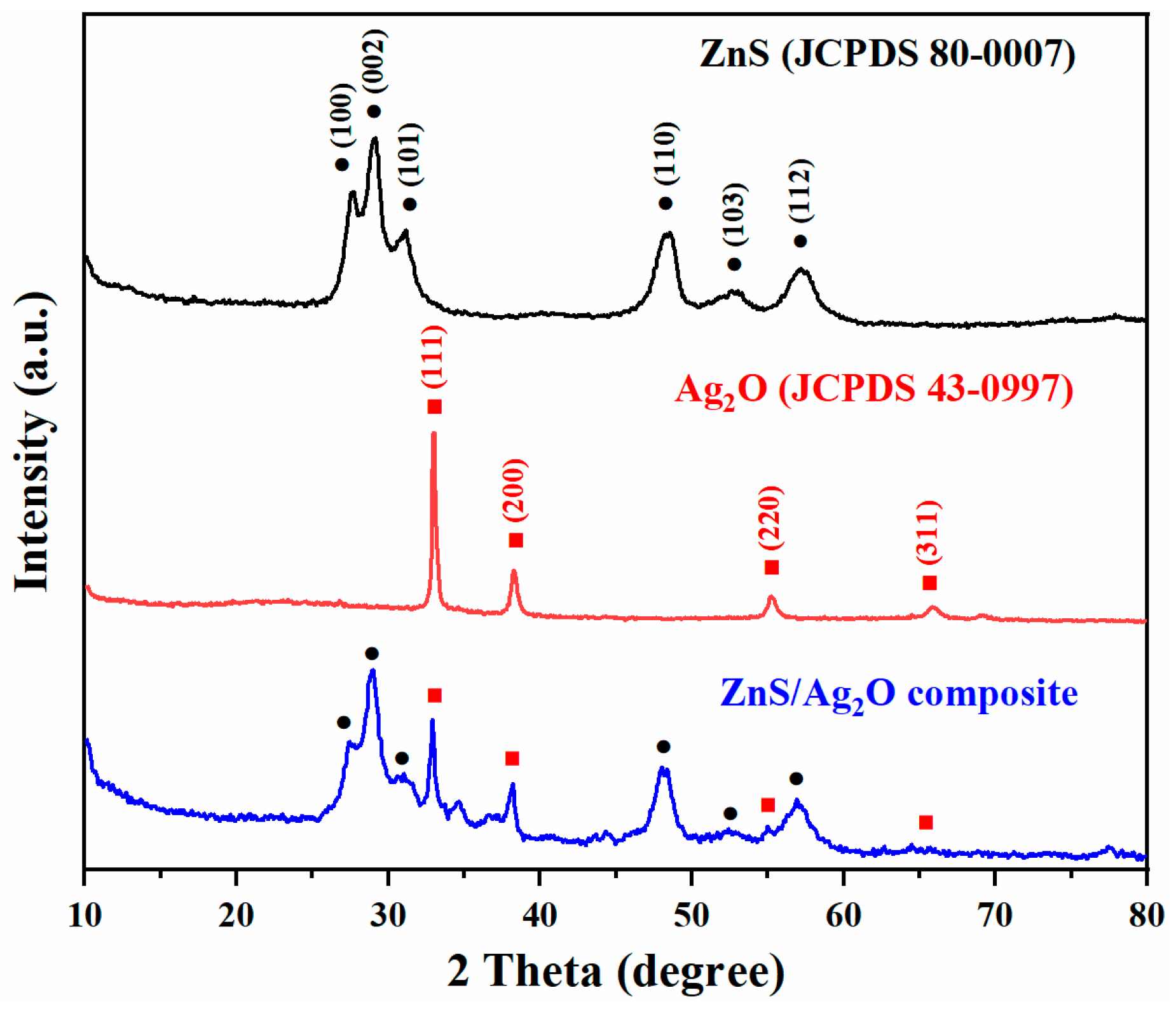
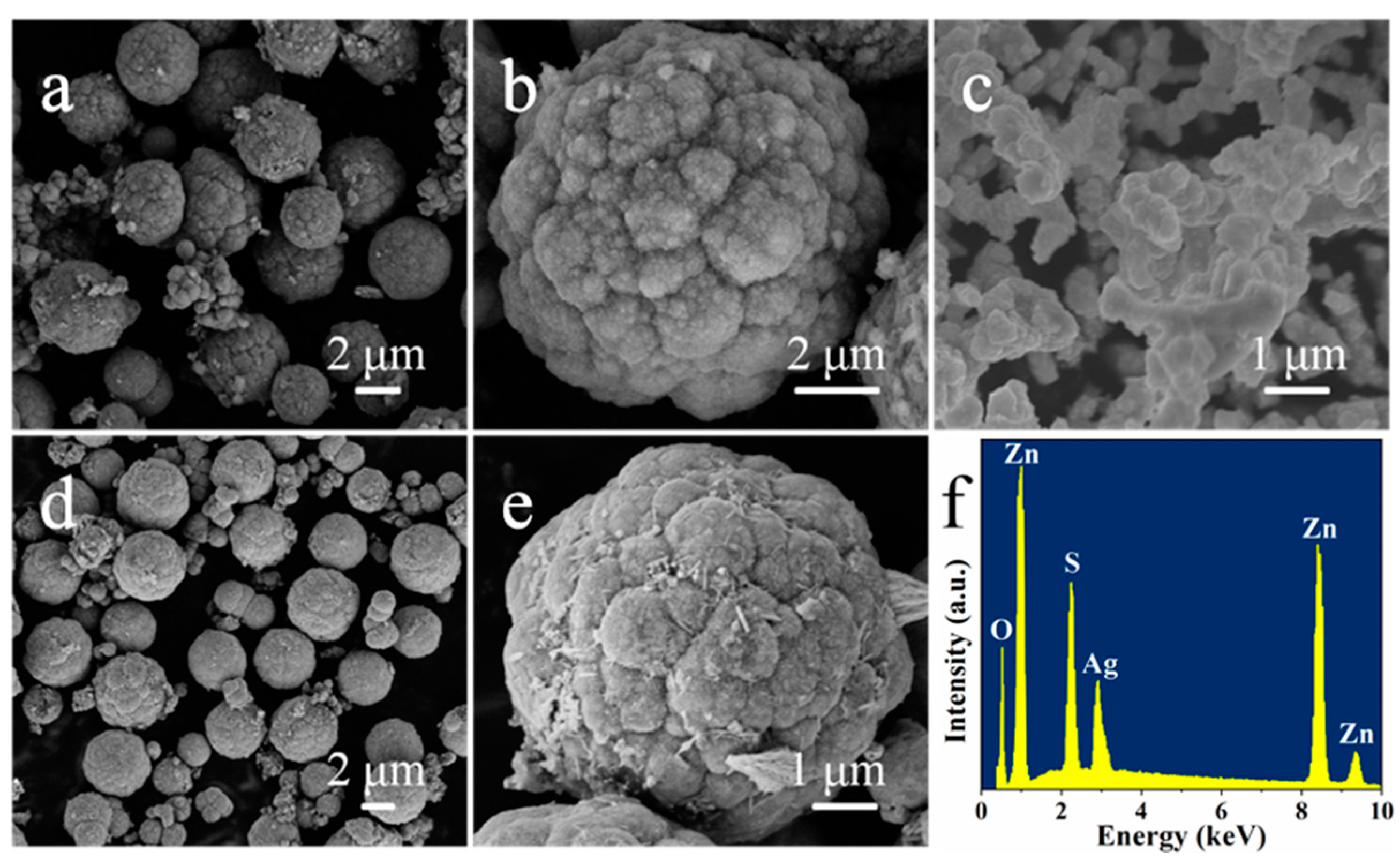

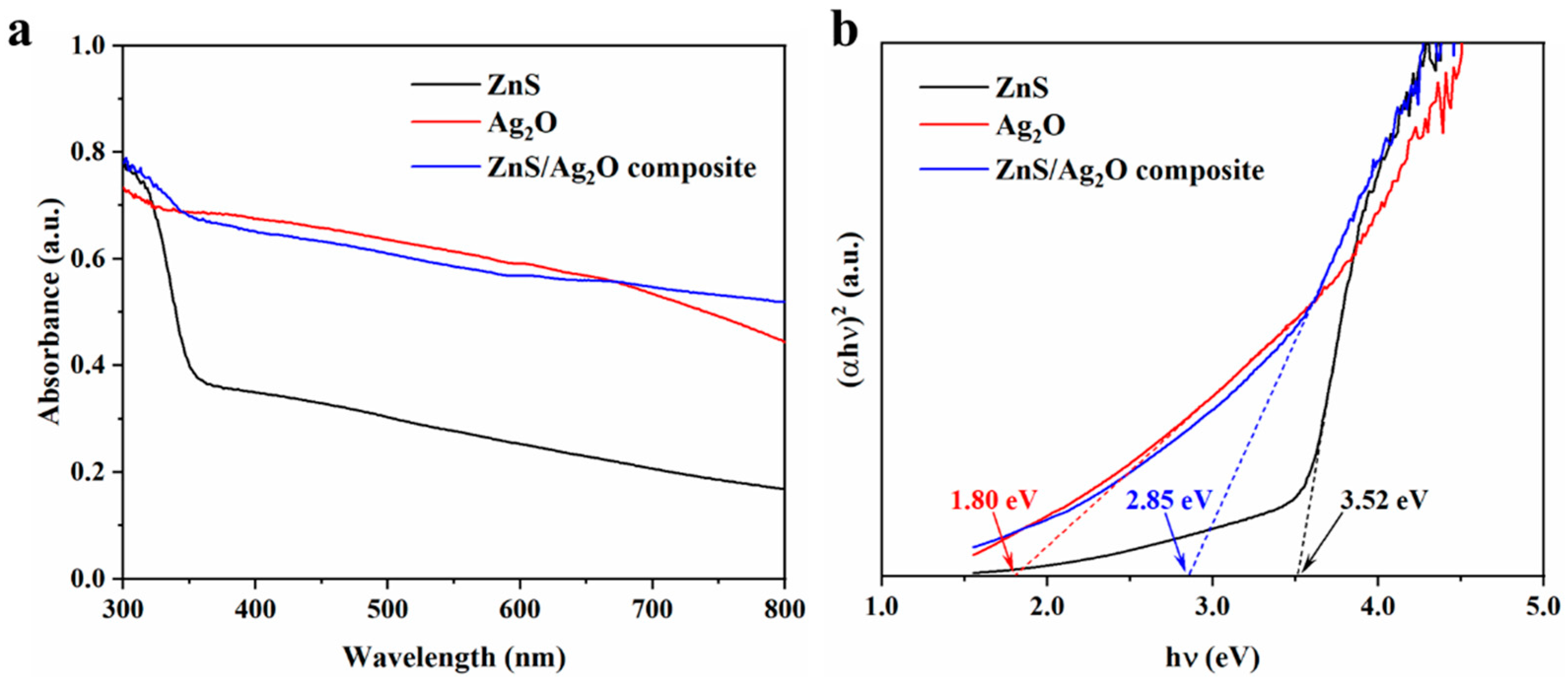


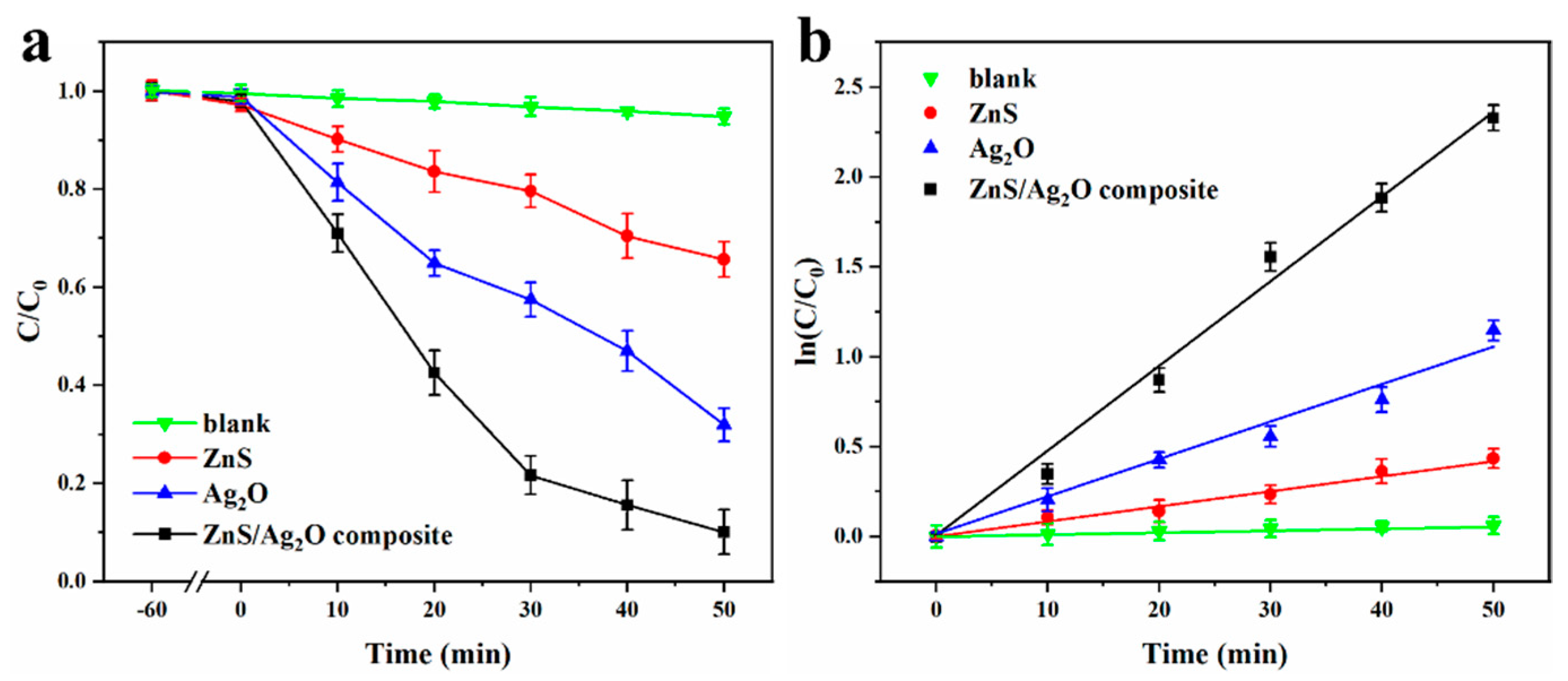

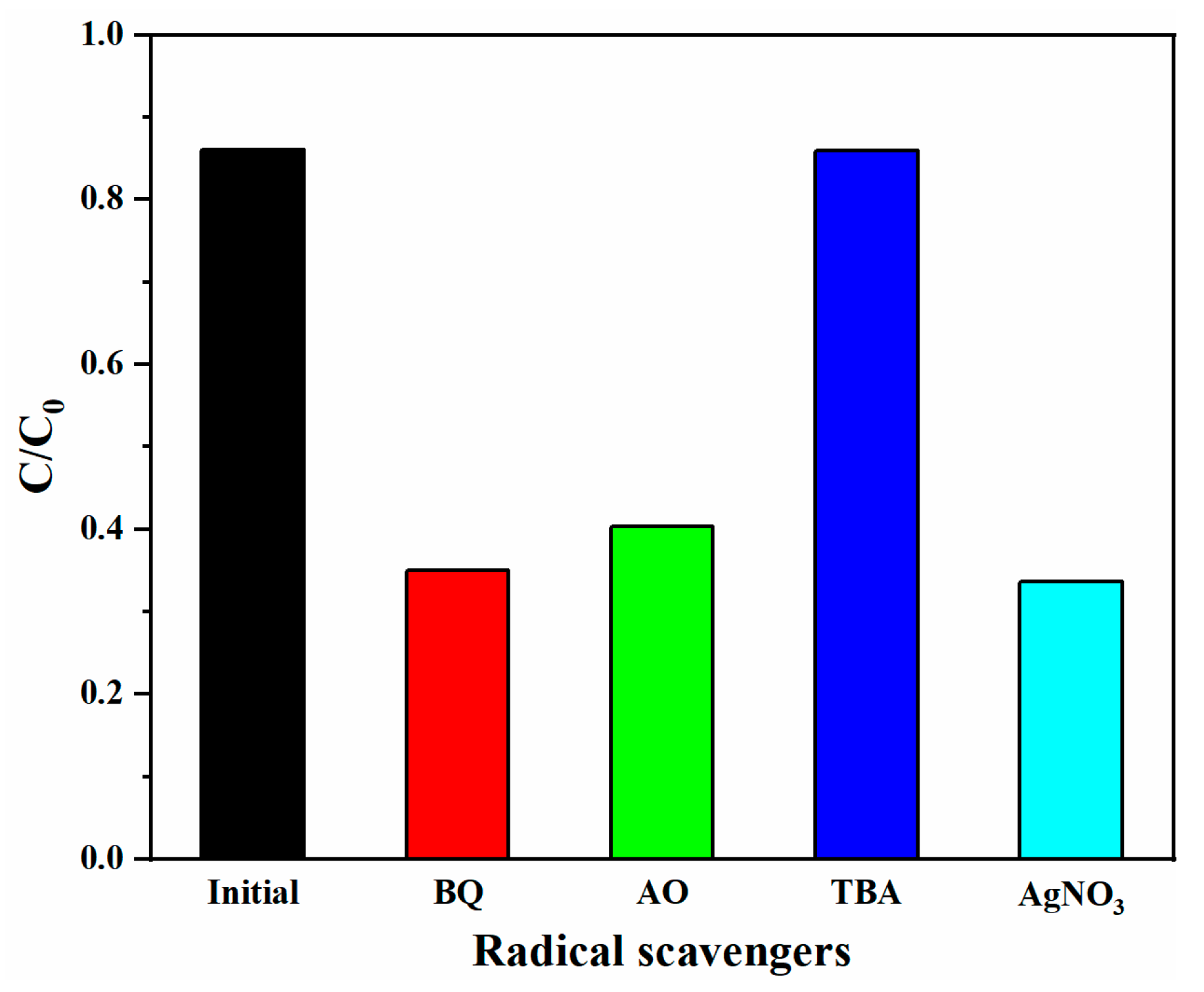
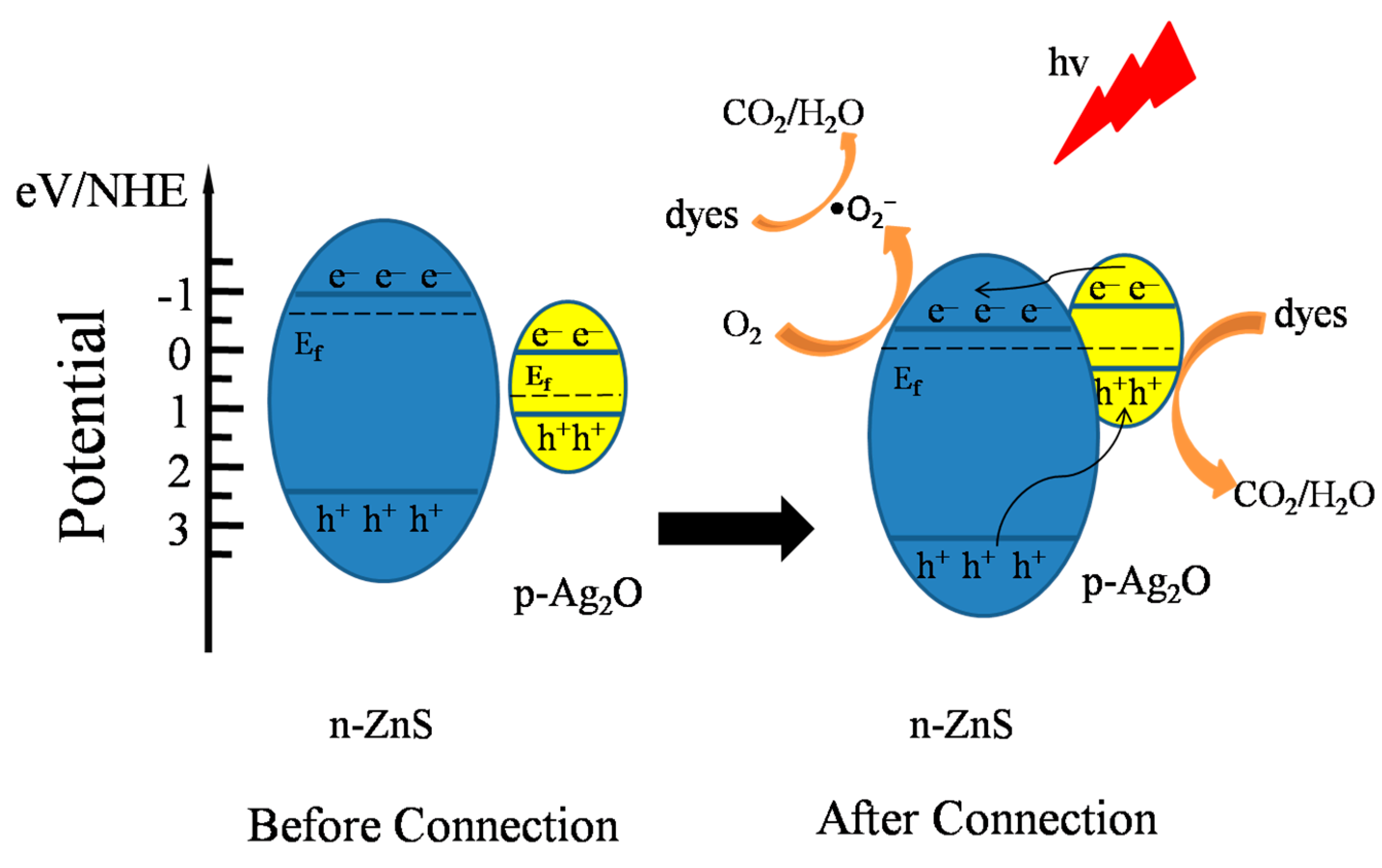
| No. | Catalysts | Structures | Rate Constants 1 | Ref. |
|---|---|---|---|---|
| 1 | ZnS/CdS | core/shell structure | 0.119 min−1 | [2] |
| 2 | ZnS/TiO2 | nanospheres | 0.110 min−1 | [3] |
| 3 | ZnS/ZnO | porous nano-crystal films | 0.041 min−1 | [4] |
| 4 | Ag@AgI/ZnS | microspheres | 0.031 min−1 | [5] |
| 5 | ZnS/SnO2 | nanospheres | 0.046 min−1 | [6] |
| 6 | ZnS/CuS | supported on reduced graphene oxide | 0.159 min−1 | [7] |
| 7 | ZnS/MoS2 | layered structures | 0.183 min−1 | [8] |
| 8 | ZnS-Fe2O3 | supported on reduced graphene oxide | 0.077 min−1 | [9] |
| 9 | ZnS-ZnIn2S4 | porous hierarchical spherical structure | 0.041 min−1 | [10] |
| 10 | ZnS/Ag2O | broccoli-like microspheres with nanorods | 0.138 min−1 | this work |
Publisher’s Note: MDPI stays neutral with regard to jurisdictional claims in published maps and institutional affiliations. |
© 2021 by the authors. Licensee MDPI, Basel, Switzerland. This article is an open access article distributed under the terms and conditions of the Creative Commons Attribution (CC BY) license (https://creativecommons.org/licenses/by/4.0/).
Share and Cite
Yu, D.; Fang, H.; Qiu, P.; Meng, F.; Liu, H.; Wang, S.; Lv, P.; Cong, X.; Niu, Q.; Li, T. Improving the Performance of ZnS Photocatalyst in Degrading Organic Pollutants by Constructing Composites with Ag2O. Nanomaterials 2021, 11, 1451. https://doi.org/10.3390/nano11061451
Yu D, Fang H, Qiu P, Meng F, Liu H, Wang S, Lv P, Cong X, Niu Q, Li T. Improving the Performance of ZnS Photocatalyst in Degrading Organic Pollutants by Constructing Composites with Ag2O. Nanomaterials. 2021; 11(6):1451. https://doi.org/10.3390/nano11061451
Chicago/Turabian StyleYu, Dequan, Hao Fang, Peikai Qiu, Fancong Meng, Haixia Liu, Shuai Wang, Pingli Lv, Xiaoyan Cong, Qingfen Niu, and Tianduo Li. 2021. "Improving the Performance of ZnS Photocatalyst in Degrading Organic Pollutants by Constructing Composites with Ag2O" Nanomaterials 11, no. 6: 1451. https://doi.org/10.3390/nano11061451
APA StyleYu, D., Fang, H., Qiu, P., Meng, F., Liu, H., Wang, S., Lv, P., Cong, X., Niu, Q., & Li, T. (2021). Improving the Performance of ZnS Photocatalyst in Degrading Organic Pollutants by Constructing Composites with Ag2O. Nanomaterials, 11(6), 1451. https://doi.org/10.3390/nano11061451






